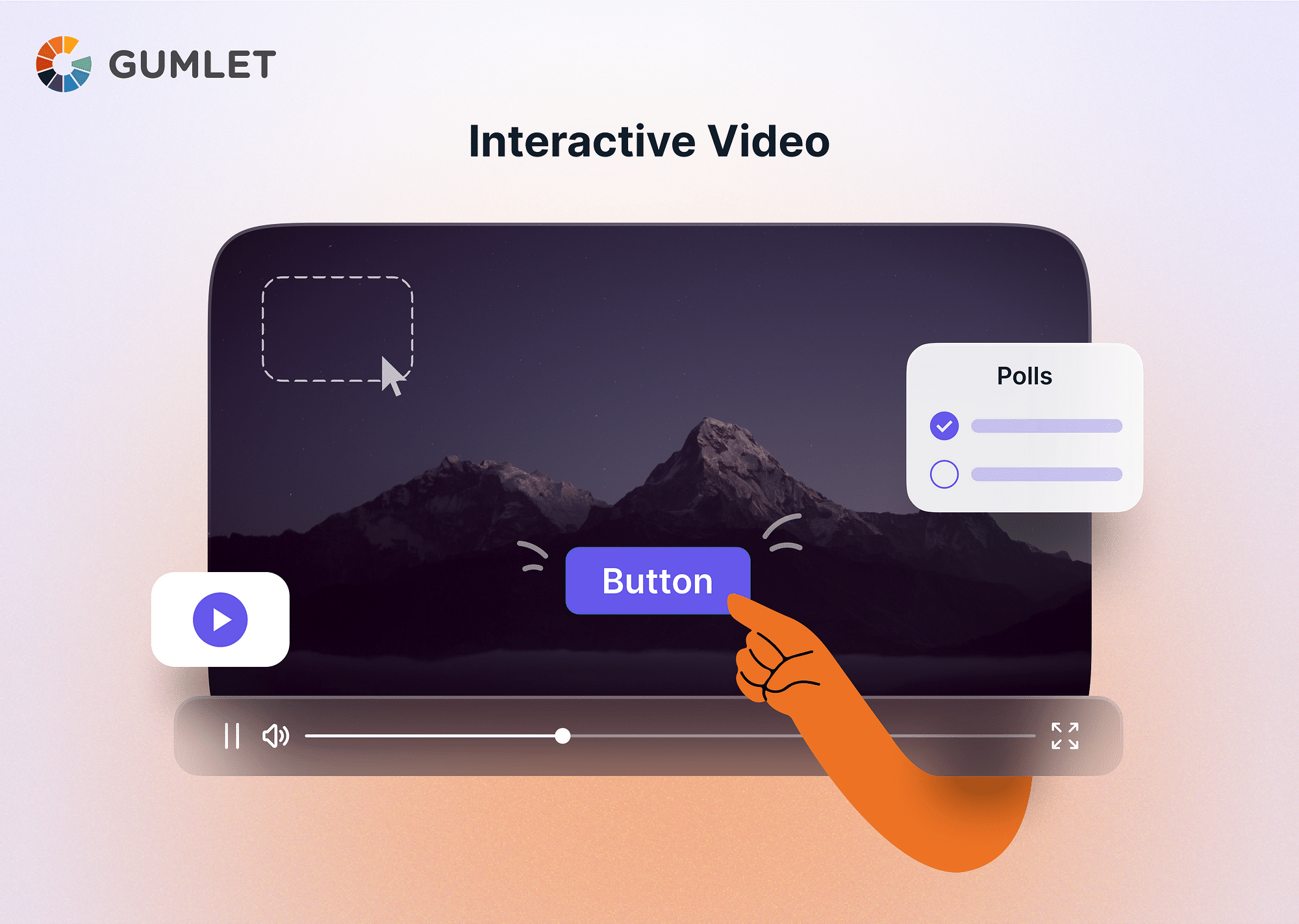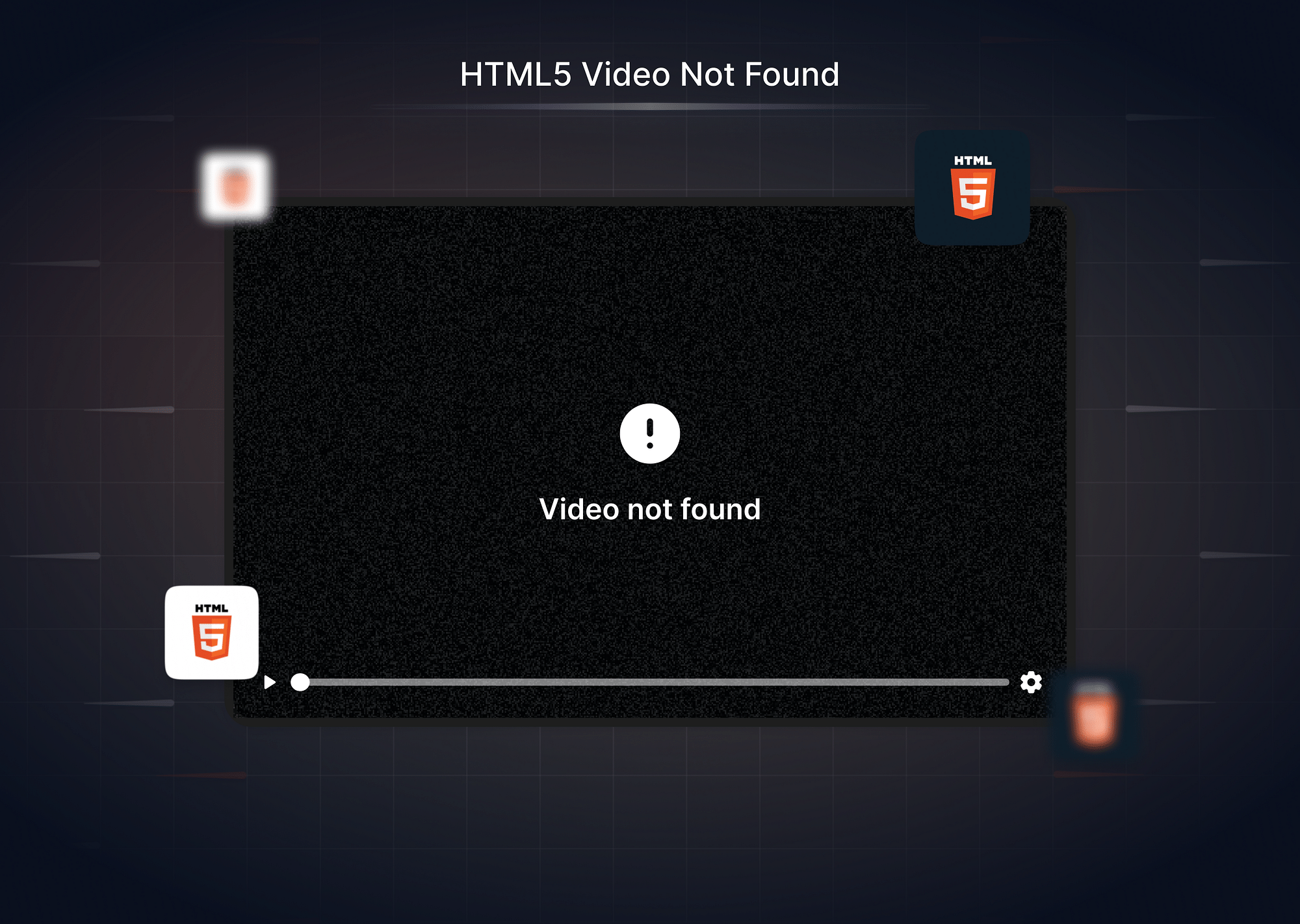What is Interactive Video?
An interactive video is a form of multimedia content that uses interactive elements to improve viewer engagement. These videos combine traditional video elements (like play, pause, fast forward, and rewind) with immersive features like clickable hotspots, branching narratives, and user-driven navigation.
Different types of interactive videos are based on the elements they use to engage viewers. Some popular interactive video examples include hotspots, quizzes, clickable buttons, forms, etc.
Schedule a Demo with Our Video Expert!
Discover how Gumlet can help you build a cutting-edge video streaming infrastructure.
Benefits of Interactive Video
According to surveys, digital marketers who include interactive videos improve their conversion rates by 25% and lead generation by 18%. But that’s not all; here are some other benefits that you can enjoy after implementing interactive videos in your strategy:
- Improved Engagement: Interactive videos are more engaging and immersive, providing a participatory experience. When viewers become active participants, they tend to have increased attention span and interest in the content.
- Data-Driven Insights: Interactive videos can provide valuable information to marketers based on user interactions. Such data sets can be used to predict viewer behavior and use them to refine content creation processes, optimize user experiences, and so on.
- Pin-Point Marketing: Interactive videos allow businesses to showcase their business products/services uniquely and creatively. As such, 93% of marketers believe using an interactive video is a great way to educate buyers about the product/service they are selling.
- Enhanced self-service capabilities: Interactive videos empower customers to solve their enquiries independently through guided tutorials and step-by-step walkthroughs. Such solutions could improve the efficiency of customer service, reduce the need for direct support, and streamline customer journeys.

How To Make Interactive Video?
Now that we know the immense significance of interactive videos in today’s digital landscape, the next question becomes even more important - how to make interactive videos?
Choose an Interactive Video Platform
Choosing the most appropriate interactive video platform as per your requirements is the most important step. There are many options - some are affordable, others are innovative, and so on. The choice should be based on your budget, requirements, and other personalized considerations. Consider exploring online video makers as part of your options, as they can provide user-friendly interfaces and a variety of templates to enhance the interactive elements of your videos.
Conceptualize the Interactive Elements
Next up, you need to figure out the purpose of your interactive video. Outline a compelling storyline for the same. Based on that, decide which interactive elements will be most suitable for your plans:
- Clickable Buttons: These buttons appear in the middle of videos. Clicking on them can reveal hidden information or redirect the viewer to a separate webpage or video.
- Branching Scenarios: In this format, users can choose between two or more scenario paths to take the video in a specific direction.
- Quizzes and Polls: It’s common for marketers to include in-video quizzes to increase user interaction and engagement.
- Hotspots: These are the clickable hotspots within the interactive video. Clicking on them will give the user access to hidden information relevant to that specific portion of the video.
- Data Inputs: Some interactive videos include certain forms or fields requiring users to input information like their names, ages, etc.
- 360-Degree Viewing: This type of interactive video lets users click and drag the screen to get a 360-degree view of the multimedia content.
Video Shooting and Production
It’s time to bring the vision to life when everything is planned and scripted. Ensure you use high-quality visuals, audio, and video storytelling to keep the audience interested. Utilizing an AI video editing app can significantly elevate the production value of your interactive videos. Make sure that key scenes and footage always align with your interactive elements.
Integrate Interactive Elements
Use interactive video tools on your preferred platform to integrate the chosen elements into your finished video content. Make sure that these elements are timed and programmed to enhance the video's narrative while providing valuable information and enhancing the user experience.
Testing and Publishing
Ensure you do not share your interactive videos with the public before testing them thoroughly. Ensure you try each viewer path and interact with each element to ensure an error-free experience for the user. Ensure that the screen size and redirection links are working properly and that the responsiveness is top-notch.
When these factors are carefully evaluated, publish it on your preferred interactive video platform and start the marketing game.
Types of Interactive Videos by Use Cases
To better understand how interactive videos work, learn how they are used in practical settings.
Education and Training
The concept of using an interactive video in education is not uncommon. In fact, it has revolutionized how information is distributed and absorbed by the masses. Here’s how different interactive elements make education and training more feasible:
- Quizzes and Assessments: Many educational institutions and training modules insert quizzes and other assessments in their videos. This allows learners to reinforce key concepts and receive immediate feedback based on their performance.
- Live Q&A: Live Q&A sessions are the lifeblood of online learning. They form the basis of real-time interactions between educators and learners, allowing a seamless and convenient pedagogical relationship.
- Tutorial Walkthroughs: Educational videos break down complex topics into step-by-step tutorials or walkthroughs. They use interactive elements like branched scenarios to make learning more accessible.
Marketing and Sales
Interactive elements have changed the game in the marketing and sales sector. They elevate customer engagement and drive conversions. As such, marketers have tried including many elements in their video marketing strategies:
- Clickable Hotspots: In many product-based marketing & sales videos, clicking on certain hotspots allows viewers to explore hidden details, features, or information about the product. This technique allows potential customers to better understand the company/product/service.
- Product Demos: Interactive product demos are game changers. They allow viewers to interact with the product virtually, testing different features, functionalities, and use cases before making the purchase decision.
Entertainment and Gaming
Many streamers and content creators in entertainment and gaming use interactive elements to create a more immersive experience for the audience. By leveraging this technology, the line between spectators and participants can be blurred significantly.
- Choose-Your-Own-Adventure: Interactive videos allow viewers to shape the storyline’s direction by choosing various scenario paths at different junctures. Including such interactive elements creates a personalized journey for each viewer.
- Mystery and Puzzle Videos: Many videos based on mystery and puzzle challenges allow viewers to participate by interacting with clues and quizzes. This multimedia format is great for deep audience engagement and cognitive involvement.
Corporate Training
The use of interactive elements can also enhance the corporate training experience. Doing so will provide an immersive and effective learning experience for employees.
- Virtual Simulation: Using interactive learning, employees can be equipped to deal with real-world scenarios in a risk-free environment. Thus, virtual simulation elements can provide an invaluable experiential learning experience while mitigating all the risks of wrong decisions.
- Interactive Training Modules: These modules use various multimedia elements like quizzes, assessments, and data inputs to have learners engage and interact with the content. They can, therefore, help learners improve their knowledge retention and better understand each topic.
The Future of Interactive Videos
Interactive videos already have a significant foothold in many global industries today. Based on their success rate, it’s safe to say that they have a promising future ahead, especially in sales and marketing.
- According to a survey, around 87.7% of marketers believe using interactive elements in their online video strategy resulted in sales growth. Among them, 78% agreed that the results were better than traditional video marketing.
- In years to come, interactive videos will continue to grow. With the advent of artificial intelligence, there’s a significant chance that interactive elements can become even more personalized by adapting in real time based on user interactions and behavior.
- It’s also possible that collaborative, interactive videos will be improved. This will allow multiple users to engage simultaneously to foster a shared viewing experience.
Based on these presumptions, it’s clear that an interactive video will soon be the center of most multimedia-based domains - including digital marketing, entertainment, online education, etc.
Conclusion
The modern digital landscape is all about visual storytelling. In such a scenario, interactive videos can create a dynamic revolution by bridging the gap between passive consumption and active engagement. A web surfer's rapidly decreasing attention span was an alarming tragedy for most marketers. Developers have been trying and failing to look for a solution for years. And now, it’s finally here in the form of interactive elements within a simple video.
Frequently Asked Questions (FAQs)
1. What is the difference between traditional and interactive videos?
Traditional videos are a passive medium that users view without interaction or participation. Only basic actions like pausing, playing, rewinding, or fast-forwarding are possible. Interactive videos allow greater participation by allowing users to make choices, get access to hidden information, or even alter the narrative of the content.
2. What are the features of interactive video?
The primary features of interactive videos include clickable elements like buttons and hotspots, branching narratives, quizzes, polls, and user-driven navigation.
3. What is a two-way interactive video?
A two-way interactive video supports real-time communication and interaction between different participants. Both parties can share audio, video, and data.
4. Can YouTube do interactive videos?
Yes, YouTube videos can include some interactive elements like end screens, cards, polls, etc. However they do not support more complex features like branching narratives.




